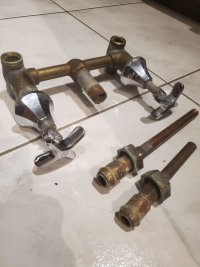DIYorBust
Active Member
Hi Folks. After some pause due to covid, I'm trying to pickup an old project I am working on with a very old 3 handle tub valve body. I think I posted on this a few years ago, but didn't get much traction during the lockdown, but I thought I'd give it another shot. It has union like tailpiece connectors like the common price pfister 3 handle shower body. My question is, do these units have a standard tailpiece and coupling nut, or does it vary by brand? Since the brand is no longer made, I'd have to have a custom piece machined, find a salvage piece, or find another solution to repair the tailpiece, none of which seems economical or easy.
I did not damage the part, it was in that condition since before I was around. Scald protection exists upstream of the assembly. It would be fairly complicated to replace the valve body, which includes a remote waste and some other odd features, and there is some nice historical tilework that would be impossible to match. However I do have access from behind.
Thanks all,
DIY
I did not damage the part, it was in that condition since before I was around. Scald protection exists upstream of the assembly. It would be fairly complicated to replace the valve body, which includes a remote waste and some other odd features, and there is some nice historical tilework that would be impossible to match. However I do have access from behind.
Thanks all,
DIY

